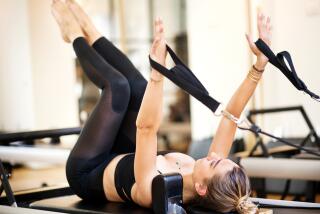Pilates Program Is Kinder, Gentler
When Diane Diefenderfer says she will bend over backward to help her clients, she means it.
At Studio du Corps in Costa Mesa, the former professional ballet dancer bends into positions that make her look like a human rubber band to show men and women of all ages how to develop lean, firm, flexible bodies.
What Diefenderfer teaches is Pilates, a non-impact exercise that offers something aerobics and weight training don’t--a balance between strength and flexibility. It also improves posture and strengthens the abdomen.
Pilates is also taught at Orange Coast College in Costa Mesa and UC Irvine.
“Ninety percent of my clients come in initially complaining of back problems,” Diefenderfer says. “Back pain is usually due to weak stomach muscles. Pilates focuses on controlling and strengthening your abdomen, which in turn strengthens the rest of your body.”
Diefenderfer’s methods are relaxing as well.
“If done correctly, you leave with a wonderful feeling of being in tune with your body and very relaxed,” she says.
A basic Pilates workout at Studio du Corps lasts about 1 1/2 hours, beginning with spinal and abdominal stretches on a mat and followed by abdominal crunches that won’t injure the back or extend the belly.
“Many people go to the gym and do a bunch of sit-ups, which only result in a bulging stomach,” she says. “Pilates teaches you to press your naval to your spine while breathing deep into your lungs, not your belly.”
Next, exercisers move to the Universal Reformer, a horizontal platform. They place their feet on the bar in front of them, put their head in the head rest, tuck in their abdominal muscles and begin a series of leg and upper-body exercises.
“All of the exercises have a prescribed placement, rhythm and breathing pattern,” Diefenderfer says. “We don’t have lots of (repetitions) because we focus on quality, not quantity. If you can only do two good crunches, then that’s all you’ll do.”
Pilates was created 70 years ago by German-born Joseph Pilates. A frail and bullied child, he grew up to become a professional boxer in England, a self-defense expert for Scotland Yard detectives and a circus performer. Interned in England during World War I because of his German heritage, Pilates developed strengthening techniques by teaching inmates bodybuilding and self-defense. He also helped injured soldiers exercise by attaching springs to their bedposts so they could work out while lying down.
In 1923, he emigrated to New York and opened a studio, attracting dance legends Martha Graham and George Balanchine and actors Gregory Peck and Katharine Hepburn. Recently, the method has attracted the interest of actress Sigourney Weaver, skater Kristi Yamaguchi and members of Ballet Pacifica in Costa Mesa.
Despite its popularity among dancers, actors and athletes, when it comes to the general public, Pilates isn’t well known.
However, that’s changing rapidly, says Janice Gudde Plastino, PhD, a dance professor at UCI. “I get from five to 10 calls a week about Pilates,” she says. “It’s becoming a really popular form of exercise.”
There is a waiting list to enroll in the Pilates class at UCI, which is only open to students, as is the Orange Coast College class.
“Many doctors are now aware of Pilates and prescribe it as an additional therapy for injuries,” Diefenderfer says. “At St. Francis Memorial Hospital in San Francisco, they have a large Pilates program used for rehabilitation.
“While Pilates doesn’t take the place of traditional physical therapy, it does strengthen muscles that would otherwise atrophy, and (it) gives the injured person flexibility.”
Diefenderfer discovered Pilates while recovering from a knee injury in 1984 when she was dancing with the Los Angeles Ballet Company. (She also performed with the Eglevsky Ballet Company in New York and was a soloist with the Frankfurt Ballet in West Germany.)
“My knee was very swollen, and my thigh almost nonexistent,” she says of her injury. “In addition to regular physical therapy, I went to Ron Fletcher’s Pilates studio in Los Angeles, where I worked my entire body while lying down. Five months later I was back on stage dancing.”
When Diefenderfer retired from professional dancing in 1986, she opened Studio du Corps (“studio for the body”) in 1987.
Diefenderfer and her instructors have trained divers, tennis players, triathletes, dancers and “weekend warriors” who are looking for the lean, long muscles and tight tummies Pilates provides.
Molly Lynch, artistic director of Ballet Pacifica, started Pilates training six years ago.
“Pilates is really useful for dancers because it helps them maintain alignment, and (it) strengthens and tones both sides of the body,” she says. “This is important because, even though it’s not intentional, dancers tend to favor their stronger sides, which can result in injuries.”
Pilates has also helped Jim Miltenburg of Irvine, a designer who competed in triathlons and marathons. “I started Pilates because I had a knee problem and also wanted more flexibility and strength in general,” he says.
After three years of training, he says his knee problems have disappeared, his body is stronger and his posture has improved.
“I even walk straighter now,” he says.
For more information about studios with trained Pilates instructors, contact The Institute for the Pilates Method, 1807 Second St., Unit 28, Santa Fe, N.M. 87501, (505) 988-1990 or Current Concepts, 7500 14th Ave. 23, Sacramento, Calif. 95820, (916) 454-2838.


